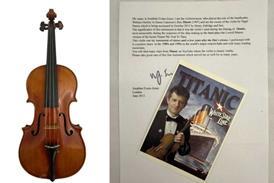The American violinist examines the role of vibrato in enhancing sound and providing character. From 2017

Wrist Vibrato and Arm Vibrato are the terms used to describe the manner of vibrating. But this terminology is inconsistent with what actually makes the vibrato. The key lies in the fingers ‘rolling’ on the string and this can only be affected by the hand. The wrist must be flexible at all times and the hand free for the vibrato motion.
The basic position of holding the violin strongly affects the manner of vibrato and vibrato speed required. Your left elbow must be well under the violin and the left hand fingers held high to give the finger tips the flexibility to rotate. Ideally, the thumb should not protrude above the fingerboard. It should be placed, preferably, on the fleshy portion and positioned slightly behind the index finger. Putting your elbow further under the violin towards the E-String side will speed up your vibrato. It is interesting to note that the use of the shoulder rest will more likely create an arm vibrato as it narrows the chance for the finger tips to rotate fully.
Vibrato plays a significant role in determining the individuality of great players. They could be immediately identified by their tone. When I was a student, I used to enjoy having recordings played without knowing who was playing and being able to recognise after a few bars who the artist was. How simple it was to identify the sound of Heifetz, Milstein, Menuhin, Kreisler and other notables by their vibrato. Interesting to note, that none of these artists used a shoulder rest.
I must add that vibrato can enhance a sound but excessive vibrato can be cloying and annoying. Vibrato must be used tastefully and varied according to the composer you are playing. Sometimes a minimum use of vibrato is needed and at times none at all. A wider vibrato, for example, can be used for Tchaikovsky and a leaner vibrato can be used for Mozart.
I have heard time and time again that teachers are telling students to vibrate every note. This is treacherous advice because in rapid passage work your hand must be steady and involuntary motion will affect intonation and mar your technique. Please remember that vibrato can be a dangerous weapon if not used wisely!
Read: Violinist Lihay Bendayan: Fourth finger vibrato
Read: Technique: Developing a controlled vibrato
Read: Technique: How to vary and enhance your cello pizzicato
Discover more Technique like this in The Strad Playing Hub



































No comments yet